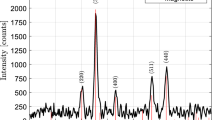Abstract
Ultrafine magnetite particles were prepared by a co-precipitation method. The poly-(styrene/N-isopropylacrylamide/methacrylic acid) latex particles containing ultrafine magnetite [magnetic P(St/NIPAM/MAA)] were prepared by two-step emulsifier-free emulsion polymerization. The minimum NaCl concentration for flocculation of these magnetic latex particles (critical flocculation concentration, CFC) decreased with increasing temperature. These temperature dependence of CFC, namely its thermo-sensitivity, originated from NIPAM. At a certain NaCl concentration, some of the magnetic latex particles showed reversible transition between flocculation and dispersion by controlling the temperature, and the thermo-flocculated magnetic latex particles were separated quickly in a magnetic field. Bovine serum albumin (BSA) was covalently immobilized onto the magnetic P(St/NIPAM/MAA) latex particles with high efficiency by the carbodiimide method. These thermo-sensitive magnetic immunomicrospheres were effective for the immunoaffinity purification of anti-BSA antibodies from antiserum.
Similar content being viewed by others
References
Dunnill P, Lilly MD (1974) Purification of enzymes using magnetic bioaffinity materials. Biotechnol Bioeng 16:987–990
Fair BD, Jamieson AM (1980) Studies of protein adsorption on polystyrene latex surfaces. J Colloid Interface Sci 77:525–534
Heskins M, Guillet JE (1968) Solution properties of poly(N-isopropyl acrylamide). J Macromol Sci Chem A2:1441–1455
Hirschbein BL, Whitesides GM (1982) Affinity separation of enzymes from mixtures containing suspended solids. Comparisons of magnetic and nonmagnetic techniques. Appl Biochem Biotechnol 7:157–176
Hoshino F, Fujimoto T, Kawaguchi H, Ohtsuka Y (1987) N-Substituted acrylamide-styrene copolymer lactices II. Polymerization behavior and thermosensitive stability of lactices. Polym J 19:241–247
Kondo A, Higashitani K (1992) Adsorption of model proteins with wide variation in molecular properties on colloidal particles. J Colloid Interface Sci 150:344–351
Kondo A, Yamasaki R, Higashitani K (1992) Affinity purification of antibodies using immunomicrospheres. J Ferment Bioeng 74:226–229
Kondo A, Kaneko T, Higashitani K (1993) Purification of fusion proteins using affinity microspheres in aqueous two-phase systems. Appl Microbiol Biotechnol 40:365–369
Lea T, Vartdal F, Nustad K, Funderud S, Berge A, Ellingsen T, Schmid R, Stenstad P, Ugelstad J (1988) Monosized, magnetic polymer particles: their use in separation of cells and subcellular components, and in the study of lymphocyte function in vitro. J Mol Recog 1:9–18
Molday RS, Mackenzie D (1982) Immunospecific ferromagnetic iron-dextran reagents for the labeling and magnetic separation of cells. J Immunol Methods 52:353–367
Mosbach K, Andersson L (1977) Magnetic ferrofluids for preparation of magnetic polymers and their application in affinity chromatography. Nature 270:259–261
Norde W, Lyklema J (1978) The adsorption of human plasma albumin and bovine pancreas ribonuclease at negatively charged polystyrene surfaces. I. Adsorption isotherms. Effects of charged, ionic strength, and temperature. J Colloid Interface Sci 66:257–265
Platsoucas CD (1987) Biomedical applications of polymer particles with emphasis on cell separation. In: El-Asser MS, Fitch RM (eds) Future directions in polymer colloids. Marutinus Nijhoff, Dordrecht, p. 321
Sada E, Katoh S, Kondo A, Kiyokawa A (1986) Effects of coupling method and ligand concentration on adsorption equilibrium in immuno-affinity chromatography. J Chem Eng Jpn 19:502–506
Setchell CH (1985) Magnetic separations in biotechnology — a review. J Chem Technol Biotechnol 35B:175–182
Shimoiizaka J (1979) Japanese patent no. 54-40069
Shinkai M, Honda H, Kobayashi T (1991) Preparation of fine magnetic particles and application for enzyme immobilization. Biocatalysis 5:61–69
Suzawa T, Shirahama H, Fujimoto T (1982) Adsorption of bovine serum albumin onto homo- and copolymer latices. J Colloid Interface Sci 86:144–150
Author information
Authors and Affiliations
Additional information
Correspondence to: A. Kondo
Rights and permissions
About this article
Cite this article
Kondo, A., Kamura, H. & Higashitani, K. Development and application of thermo-sensitive magnetic immunomicrospheres for antibody purification. Appl Microbiol Biotechnol 41, 99–105 (1994). https://doi.org/10.1007/BF00166089
Received:
Revised:
Accepted:
Issue Date:
DOI: https://doi.org/10.1007/BF00166089




